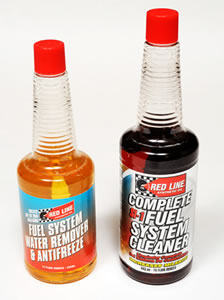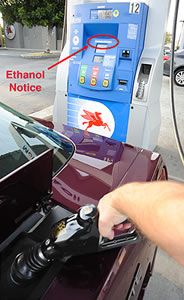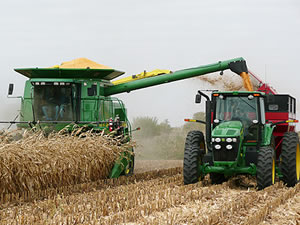Corvette Action Center Deep Dive Series: Gasoline for your Corvette - Page 3 of 8
 |
 |
Page 3 of 8
© 2009 by Hib Halverson
No use without permission, All Rights Reserved
![]() Discuss this article
Discuss this article
There are two types of pour-in cleaners: solvent-based and detergent-based. The majority are solvent-based because they are cheap to make. Unfortunately, solvents strong enough to effectively clean a fuel system also attack its rubber and plastic parts. Because the manufacturers of these additives obviously don't want their products to dissolve components in the fuel systems their users are trying to clean, none have solvent bases strong enough to remove significant amounts of the contamination some people buying injector cleaners want to remove. Some people, thinking the solution is simply to increase the concentration of solvent, may damage their fuel systems.

Red Line Oil makes two other gasoline additive products, Fuel System Water Remover and Antifreeze and, on the right one of our favorites, SI-1 Complete Fuel System Cleaner. Image: Author.
Detergent-based injector cleaners use chemistry similar to that of detergent additive packages blended by refiners into gasoline. No refiner uses any solvent-based additives as deposit modifiers. Detergent-based products are more expensive to manufacture and, because that pushes up their retail price, they may be harder to find at the mass market level. Nevertheless, detergent-based injector cleaners are a better choice. They do not attack the rubber or plastic in fuel systems, so they can have high strength with no detrimental effects. The most popular detergent-based cleaners are Chevron's Techron, Red Line Oil's SI-1 Complete Fuel System Cleaner and Lucas' Fuel Treatment.
The Corvette Action Center has used Red Line SI-1 for more than 15 years in many different carburated and fuel-injected (both '57-'65 Rochester mechanical and '82-'09 electronic) engines, some in Corvettes and some in other vehicles. Visual inspection of carburetor and injection parts and flow testing of electronic injectors from fuel systems regularly treated with SI-1 has shown these systems stay almost as clean as new and the injectors actually can flow slightly better than when new. Our maintenance dose of Red Line SI-1 is 4-oz. per 10 gallons of gas at every third or fourth fill-up. Detergent-based injector cleaners are sometimes effective in eliminating modest cases of pre-existing injector and intake valve fouling. In that case, use the shock treatment, which is a 16-oz bottle of a detergent-based cleaner per tank-full of fuel for three fill-ups. If that doesn't fix the problem, it's unlikely the fouling can be removed with a pour-in additive and other methods-typically, off-car, ultrasonic cleaning of injectors, more aggressive de-carbonizing with non-pour-in chemicals, or cylinder head removal to clean valves and combustion chambers-will be required.
In Tears Over all those Tiers?
"Top tier detergent gasoline" is recommended for use in '04 or later Corvettes. This may be a little GM spin, intended to reduce warranty costs, mixed with some fact. Since 1995, according to www.toptiergas.com, "...most gasoline marketers have actually reduced the concentration level of detergent additive in their gasoline by up to 50%." Reality is that, while some oil companies did reduce the amount of detergents per volume of gasoline, since additive technology has improved in 15 years, actual detergent performance of the gasolines remained about the same. According to other content at that website (a whois search shows the domain owner is General Motors) top tier gas is a move by GM and six foreign car makers to insure the durability of-and reduce their warranty costs related to-exhaust emissions controls of 2004 or later vehicles which meet EPA's, more stringent, "Tier 2" emissions regulations. To meet Tier 2, the engine controls must hold exhaust emissions in a more narrow range and that makes the systems less tolerant of changes in emissions caused by fuel system and combustion chamber deposits. Top tier gas also mandates an 8-10% ethanol content, specifies certain other blending requirements and has more stringent specs for intake valve and combustion chamber cleanliness.
While top tier pump gas contains detergents in high enough strengths to prevent even modest levels of contaminants from developing on injector nozzles and intake valves and in combustion chambers of engines most prone to problems with deposits; what happens when you operate your '04-up Vette where top tier gas isn't available? If that situation is temporary, nothing will happen. If it's very long term, you could have trouble with the car's emissions controls if the engine has a lot of miles on it or the engine sees a lot of short trips. If the engine is still under its emissions warranty, GM pays to fix it. If it's out of warranty, you pay.

Ok. We hate engine gunk, too, so we tried Shell's V-Power in our ZR1. Did we notice a difference? Nope. Nevertheless, we'll keep using Shell or any of the other name-brand premiums-probably the one with the lowest price. Image: Author
While top tier gasoline can keep deposits to levels which limit car company warranty costs, will they keep them low enough for highest performance over a long period of time? Possibly not. If you can't get top tier gas or you don't want to worry about tiers, but you want enough detergent to keep injectors and carburetors as clean as new; regular use of a pour-in, detergent-based injector cleaner in the maintenance dose listed earlier is be a good idea whether use top tier gas or not.
And, what of one of the latest oil company marketing campaigns: Shell's "nitrogen-enhanced" gasoline? This clever promotion has some thinking Shell discovered a previously unknown property of nitrogen and it is the only way you can keep your car's engine from developing some of Shell's infamous "gunk". At this writing, in late April '09, Shell has released only limited information on the science behind this new product and we could find no independent testing of it. Typically, when a new gasoline blend is supported by a massive advertising campaign but only limited amounts of technical information; its practical benefit will be modest, at best. In the last half-century or so, Shell Oil in particular, has been remarkably adept at getting consumers to believe it has discovered miracle chemical additives which make its gasolines a measure better than other major refiners' products. Remember Shell with "Platformate" or, later, "TCP" (tri-crestyl phosphate)? Very few of the ingredients to which Shell gave those trademarked names were unique and the generic forms of nearly all of them have been used by most major oil companies blending gasoline for automotive applications.
Once you sift through the marketing gunk, you'll read Shell's explanation that nitrogen in the detergent package used by "V-Power" premium unleaded gas is to improve the thermal stability of the additive package, rather than to directly accomplish some further reduction of combustion deposits which competitors' products cannot achieve. Additionally, while a nitrogen-enhanced detergent might be new to Shell V-Power, nitrogen has been used in the past by other refiners to increase the thermal stability of detergent additives. Shell's "nitrogen-enhanced" gasoline is a great product, but so are all the other major brands of premium gasolines. It is no better or no worse at insuring a low level of deposits in your engine than other, similar products.
Shell is careful in its advertising and in the "tech-light" information it has made available to only compare the level of "engine gunk" reduction by V-Power premium to that of what it calls "lower-quality" gasolines, rather than products which compete directly with V-Power. We suspect this is because not only Shell, but all the refiners which blend gasolines to meet top tier standards, are using nitrogen to increase the thermal stability of their detergents and, because they all use it; nitrogen-enhanced Shell V-Power is unlikely to be a practical improvement over other name-brand premium unleaded products.
Bottom line: if you buy gas from any station which pumps a high-volume of top tier gasoline, your engine will not have trouble with gunk. On the other hand, if you use some little-known brand of fuel from the cheapest source you can find and do so for a long period of time; you may experience improved performance after you switch to Shell's new fuel, but you'll experience the same result if you switched to Chevron, Conoco/Phillips or Texaco premium, too. For that matter, from a combustion deposit standpoint, you can keep using cheapest gas you can find, as long as you, also, use a detergent injector cleaner, such as Red Line SI-1.
Oxygenates in RFG:

"Originally, there were two oxygenates, MTBE and ethanol," Rocket Brand Fuel's Tim Wusz told us. "Today, many states-my current count is 16-have banned MTBE and the oxygenate in U.S. gasolines is ethanol which is an alcohol," Tim Wusz states. "It was originally blended into gasoline to increase octane but later found to reduce exhaust emissions. At one time, the oxygen in its molecules reduced emissions by enabling more efficient combustion." Image: Author.
The Clean Air Act of 1990 mandated oxygenated gasoline and its newer, more complex sibling, reformulated gasoline (RFG), in parts of the country with air quality problems. The intent was reductions of hydrocarbon and carbon monoxide emissions beyond those possible by 1980s emissions controls alone. Widespread distribution of gas oxygenated with methyl tertiary butyl ether (MTBE) began in the early-90s but, after a decade of use, its classification as a possible human carcinogen and being documented as a ground water pollutant, public opinion grew against it. California outlawed it on 1 January, 2004 and other states followed. That pressured the oil industry to phase out MTBE. At this writing in the late Spring of 2009, MTBE is not used anywhere in the U.S. Today, ethanol fulfills the Federal requirement for a gasoline oxygenate.
By the mid-'90s, improvements in combustion chamber design, emissions control hardware and engine controls software accomplished significant HC and CO reduction beyond what was coming from RFGs. With the amount of pre-mid-90s vehicles on the road becoming less and less so, from an emissions perspective, RFGs are a solution looking for a problem.
While cars built in the last 10-12 years don't require RFG to achieve low emissions, ignorance or disbelief of that by environmental activists, politicians prostituting themselves to the environmental movement along with ethanol advocacy by large agribusinesses make its presence in gasoline inevitable and permanent. Environmentalists never give up and the newest rationalization for corn-ethanol in gasoline is it helps reduce "dependance" on foreign oil.
In any event, ethanol has become the new oxygenate and it's here to stay. California requires at least 5.8% ethanol in pump gas. Other states may differ but, generally, ethanol content varies from 6-to-8 percent but, in a few areas, goes as high as 10%, the current limit. There are still some rural areas, where RFG is not required and, in those areas, refiners still distribute gasolines which are not oxygenated.
Ethanol's negatives? There's evidence that increasing ethanol production for RFGs and E85 (we'll cover that in a bit) is causing food prices to rise world-wide because more of the corn grown in the U.S. is being bought by makers of ethanol than by food producers. Ethanol is a net energy loser in that it takes more energy to make it than it releases when burned in an engine. Nobel Laureate, Paul Crutzen, an atmospheric chemist world-renowned research into the depletion of the ozone layer, did a study and found ethanol produced from corn has a net climate warming effect when compared to oil.
"On the positive side," Petrochemical Engineer and Rockett Racing Fuels V.P., Tim Wusz, told us, "the Government and the private sector are looking into making fuel-grade ethanol from biomass, green waste and so forth, but that is still in the research and testing stage. So-called 'cellulosic ethanol' is still a ways from volume production but if it gets there, it will be a better source than using corn which could be used for other things, such as feeding the world."
A downside of burning RFG in 1970s Corvettes with stock carburetors, which were lean-calibrated to reduce emissions, can be an overly-lean air-fuel ratio. Performance and drivability may be compromised by the existing calibration when combined with additional leaning due to RFG. The solution is to slightly richen the calibration. Engines built before the late-'60s often ran slightly rich and have less problems using oxygenated fuels. Engines built after 1979 for sale in California and after 1980, nationwide, have computer controls which may compensate at part throttle, but may need to be recalibrated to optimize air-fuel ratio at wide-open throttle.
Two additional caveats apply to ethanol RFG in some older vehicles. It may release scale from the walls of old fuel tanks. The solution is either frequent replacement of fuel filters while the scale is going through the system or a new tank. Ethanol is incompatible with some types of rubber fuel system parts. If hoses, or other rubber items, date to before 1990; replace them with modern products which are compatible with RFG.
Going forward, enthusiasts of older Corvettes (generally 1981 and older, but in certain cases, as new as 1995) need to beware of what the Obama Administration may do with RFG. Under pressure from agribusiness, EPA may increase the maximum limit for ethanol in RFG from 10 to 15%. This move was initiated in April of 2009 with a petition filed by a "big-ag" trade organization which lobbies for regulations favorable to ethanol producers. This was followed in early May '09 by the Secretaries of Agriculture and Energy along with the Director of the EPA announcing formation of an interagency action group which will pressure automobile manufacturers to make more vehicles capable of running on fuels with a high percentage of ethanol. There is little opposition in Congress and the Executive Branch to big-ag's petition and, at press time, political winds are blowing in favor of EPA allowing the increase.
 |
 |
Gasoline, reformulated with as much as 10% ethanol, is sold in most urban and suburban areas of the U.S. Any pump dispensing "RFG" must have an "ethanol warning" somewhere in view of the customer. In the case of this Mobil station in Cali-fornia, the warning is dead center above the pump's quantity and price displays. Image: Author. |
Gasoline in the U.S. is oxygenated with ethanol and, today, virtually all of it comes from corn. Right now, the ethanol producers compete with food producers for raw material. That's been good for big-ag, but not so good for those of us who like Corn Flakes for breakfast and corn on the cob for dinner. Image: Iowa State University. |
The trouble an increase in the ethanol limit may pose to owners of older Vettes depends on how old the car is. Additionally, in some cases, the extent of problems created by running 15% ethanol through older fuel systems cannot be predicted because little data exists about the reliability/durability of 20-or-more-year-old fuel system components in that circumstance.
Corvettes with carburetors will need jetting changes for the reasons discussed earlier. Metal parts (ie: walls of fuel tanks without rubber bladders and carburetor float bowls) could experience corrosion accelerated by the higher concentration of ethanol. Durability of rubber or plastic fuel system parts which are not compatible with current levels of ethanol in RFG will be decreased more rapidly. Solutions to these problems may exist but, in some cases, could be expensive and labor-intensive. Most involve replacement of existing parts with new items which are compatible with RFG. Additionally, if the aftermarket doesn't respond with RFG-compatible parts, there might be no solutions to some problems other than replacing parts more frequently as they fail due to the increased ethanol.
Older Corvettes with engine computers, which for the purposes of this discussion are '80/'81 to about 1990, when fuel systems compatible with alcohol-blended gasolines and RFG became widely available, may have some of the same problems. Additionally, if the engine controls of those older cars do not have enough range in their feedback fuel control to skew the air-fuel ratio towards the more rich mixture required by 15% ethanol, then those systems may require a change of software or even hardware in the form of different injectors or they may require service or overhaul to restore the fuel control range lost by faulty or worn parts.
Vettes built after 1990 generally are compatible with alcohol in gasoline, but it is unknown if they will tolerate as much as 15% ethanol as well as they currently tolerate the 6-8% typical of pump gas, today. It also is unknown if their engine controls have adequate dynamic range in closed loop fuel control, but if they do not, at least the ECMs in 1994 or later cars will be easier to reprogram.
In the end, be it a 10% or 15% limit on ethanol in pump gas, we have the same set of negatives with RFG: 1) today, oxygenated fuels are a solution looking for a problem, 2) the only party benefitting from RFGs is big-ag, 3) they're a net energy loser and 4) you pay more to buy corn flakes, corn oil and corn-on-the-cob to cook on the grille during backyard BBQs.
If you're not happy with the idea of the money and work necessary to modify an older Vette to be compatible with a higher level of ethanol in RFG, contact your Congressional representatives and express your opinion because, if the EPA allows refiners to go to a 15% limit on ethanol; it could mean a big, stinking pile of "not good" for older Corvettes.
 |
 |